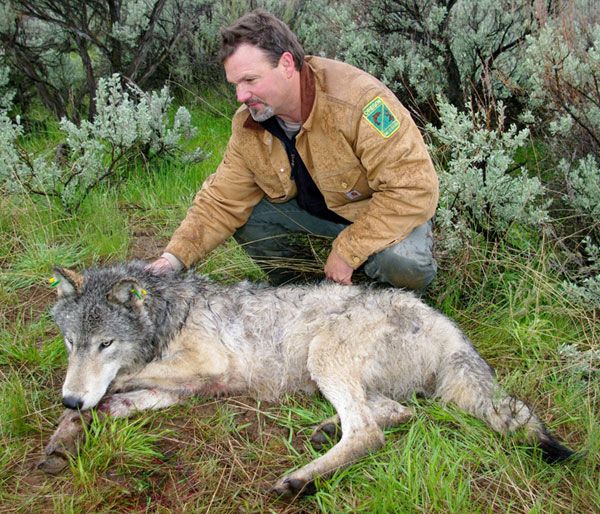Biologists catch, attach radio collar to lamb-killing wolf
Published 3:30 pm Tuesday, May 5, 2009

- ODFW photo Immobilized by a drug, a 2-year-old, 87-pound male wolf is examined by ODFW wolf coordinator Russ Morgan after it was trapped Sunday morning. The wolf was fitted with ear tags and a radio collar. - ODFW photo
BAKER CITY – Curt Jacobs used to call himself a rancher.
Trending
But since the wolves came around a few weeks ago, Jacobs has been feeling more like a security guard.
Except he doesn’t feel all that secure, even though biologists on Sunday morning attached a radio collar to the neck of one of the two wolves that killed 24 lambs on Jacobs’ Keating Valley ranch last month.
“We’ve still got to maintain a security system with him (the male wolf that was trapped) out there,” Jacobs said.
Trending
“The only thing is he’s got a collar on now.”
As a result, biologists from the Oregon Department of Fish and Wildlife and U.S. Fish and Wildlife Service will be able to track the wolf’s movements.
In addition, Jacobs said ODFW officials told him they would give him a device designed to scare away wolves. The device, which senses the signal from the radio collar, blares noise if the collared wolf comes within one-quarter mile of the device.
Two ODFW workers found the
2-year-old, 87-pound male wolf in the trap about 7 o’clock Sunday morning in the hills a couple of miles north of the valley.
This is the first time officials have affixed a radio collar to a wolf in Oregon.
The first confirmed case of a wolf migrating from Idaho to Oregon happened in 1999. There had been no definitive evidence that wolves had killed livestock here until Jacobs found dead lambs in their pen on his ranch in mid-April.
The ODFW employees who checked the trap Sunday morning also saw a second wolf – a smaller animal that biologists believe is a female – run from the trap site.
The trap was set up about 4 1/2 miles from the Jacobs ranch and about 2 1/2 miles north of Tik Moore’s ranch. Wolves killed a calf on Moore’s ranch last month.
Moore said this morning that ODFW officials told him they would deliver one of the noise-making devices to him before noon today.
But like Jacobs, Moore doubts trapping one wolf and looping a radio collar around its neck will drive the animals away from Keating Valley.
“They’re predators, and they’ve found an easy food source,” Moore said. “I think they’re going to continue to be an issue in this area. Wherever wolves go in Oregon we’re going to fight this battle over and over again.”
Moore said the wolf-detecting device might, however, give him and Jacobs enough warning to thwart future attacks.
“At least we’ll know if the wolf comes around again,” Moore said.
Russ Morgan, the ODFW’s wolf coordinator, said he and Hans Hayden, a wildlife technician at the agency’s La Grande office, found the wolf in the trap they set up last week.
As they were driving toward the trap, they saw a smaller wolf run from the area, heading north toward the forests of the Wallowa Mountain foothills above Keating Valley.
Morgan said that based on its smaller body and track size, compared with the trapped male wolf, he believes the wolf that fled is a female that is traveling with the male.
Morgan said wolves sometimes will linger where another wolf has been trapped.
The trapped wolf is not capable of breeding now, Morgan said.
After using a syringe-tipped pole to inject the wolf with an immobilizing drug, he and Hayden took blood, tissue and fecal samples, then fitted the wolf with ear tags and the radio collar.
The drug wore off after about one hour, and the wolf ran away in the same direction as the smaller wolf, Morgan said.
ODFW will notify local ranchers and other residents if the radio signals show that wolf has returned to Keating Valley or moves close to another place where there are homes and livestock, Morgan said.
“We are in regular contact with area ranchers, and not just the two (Jacobs and Moore) that have had depredation,” he said.
Agency workers also will “actively haze” any wolves that wander into such areas, Morgan said.
“We want the wolves to feel unwanted there,” he said. “The whole idea is to keep (livestock) depredation from happening.”
Morgan said ODFW has been setting traps in several places near Keating Valley since mid-April, when wolves killed two dozen lambs on the Jacobs ranch.
Workers check the traps each morning.
They hadn’t captured anything until Sunday.
“And it happened on the rainiest morning of all,” Morgan said.
He said his truck “barely” made it through the mud to the trap, which was set up in open sagebrush country.
The baited traps have rubber-coated jaws that are designed to capture, but not hurt, wolves.
Morgan said the male wolf trapped Sunday suffered only a minor abrasion to its foot, typical with such traps.
The wolf was “fairly lean,” but healthy, he said.
He thinks it’s likely that the two wolves are the same pair that a motion-sensing camera photographed inside the lamb pen at the Jacobs Ranch last month.
Morgan said the tracks the wolves made near the trap are the same sizes as tracks he has found at the Jacobs Ranch and elsewhere.
“Those two tracks have become familiar,” he said.
Morgan theorizes that the male wolf was born during the spring of 2007, and that it separated from its mother perhaps six months ago.
Wolves often “disperse” at the age of about a year and a half, he said.
The second wolf might not be related to the male, but it’s also quite possible that the pair are siblings that dispersed at the same time, Morgan said.
The blood samples will show whether the male wolf is related to wolves in Idaho.
Morgan said that’s almost certainly the case.
However, even if it is, the genetic link would not tell biologists whether the trapped male wolf was born in Idaho or in Oregon.
ODFW officials know of only one wolf pack in Oregon – in northern Union County.
Morgan said ODFW will not continue to set wolf traps in the Keating area.
However, biologists might try to capture the second wolf if they see the animal while they’re on an airplane flight searching for the radio signal from the male wolf’s collar.
In that case they might use either a net gun or a dart that injects an immobilizing drug, Morgan said.
If the two wolves are traveling together, however – and Morgan thinks that’s likely – then having one wolf radio-collared is almost as useful as collaring both animals, he said.
In related news, Suzanne Stone of Defenders of Wildlife said Friday that the organization had sent the Jacobses a check for $3,150, the amount the couple requested for the loss of their sheep.
Jacobs said he received the check.
Stone said this morning that based on experiences in Idaho and other states with wolf populations that number in the hundreds, trapping and radio-collaring a wolf tends to be a more effective deterrent than other methods.
“It’s more likely that the wolves will depart the area, head for the high country and go back to hunting native prey,” Stone said.
But compensation aside, both he and Moore said they will continue to advocate for a bill in the Oregon Legislature that would allow ranchers to kill wolves that attack livestock.
That’s illegal now because wolves, although they were removed from the federal endangered species list on Monday, are still protected under Oregon law.
“We need the authority to take out the bad wolves,” Moore said. “I don’t necessarily mean killing them. But trapping a wolf and releasing it in the same place, what good does that do anybody? Take it to a wilderness area and give it a second chance there.”
Jacobs predicts that even if wolves stay away from Keating Valley, they will prey on cattle and sheep that will spend the next several months grazing on higher-elevation range around Baker County.
“I think there’s going to be a lot of ranchers who lose livestock and they won’t even know it until this fall when their animals are brought in,” Jacobs said.
The trouble with that scenario, he said, is that ranchers probably won’t be able to prove that wolves were the culprit.
“We’ll be back to defending ourselves again,” Jacobs said.
Moore said he doesn’t know what to expect.
“Like I told the Legislature last week, my wolf learning curve is straight up right now,” Moore said. “I’m learning more about wolves than I ever thought I would know or care to know.
“And I don’t know that much.”









